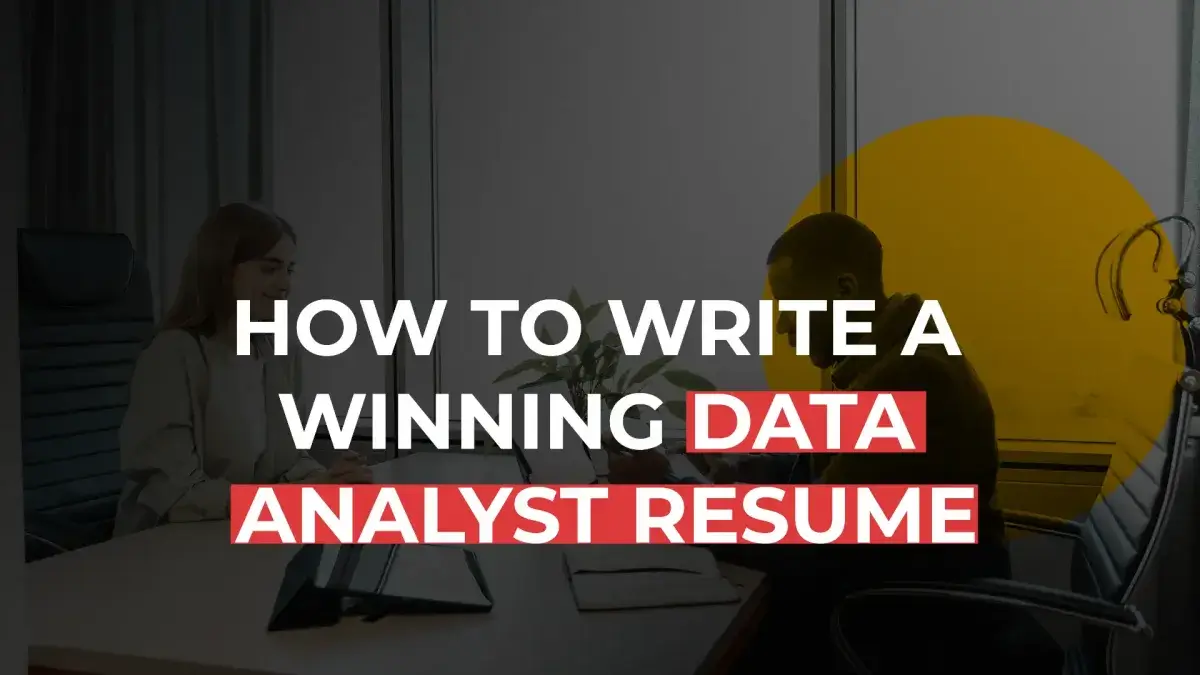Creating a Winning Data Analyst Resume: A Guide

Here's What We've Covered!
You only have six seconds. Maybe eight, if you are lucky.
That is the average time a recruiter takes to read one resume before moving on to the next.
That’s it. That is the only window to make an impression. It will take you longer to finish reading this paragraph. That is a lot of pressure on your resume. As a data analyst entering the job market, you should play your cards wisely. For every job available, there could be dozens, even hundreds of applicants. Top companies such as Amazon, Google, Flipkart, Jio and Accenture are just a few of the many organisations hiring data analysts. Competition is tough. The battle over the recruiter’s attention is fiercer. You need to ensure that with a quick glance at the page, your crucial data is scanned immediately. There is an art to writing the perfect data analyst resume. By the end of this blog post, you’ll know a few tricks for creating a winning resume that holds a recruiter’s attention.
Why is it crucial to create a winning data analyst resume?
Your CV or resume helps the recruiter form a first impression of you. It is your calling card & shows you have the skills and educational background needed for the job.
It can also reflect on you as a person. A well-structured resume that neatly lists all the important points shows you are an organised, thoughtful person who will work on data analysis in a similar methodological manner. A data analyst’s resume with too much jargon, too many pages and long, winding sentences will end up living in the recycled bin.
Also Read – 14 Excel functions every Data Analyst must know
Step-by-step guide on how to write a data analyst resume
As a newbie, your resume should not extend beyond a page. Divide it into two sections. One-fourth is on the left side, and three-fourths is on the right. The left side will have bulleted points listing your contact details and skills. The right side will contain your summary, work experience and education. Refer to the sample resume below to get a better idea. Below are all the ingredients you need to cook up a killer data analyst resume.
-
Start with a short but neatly written profile
Write between 300 to 400 words about you. Try to sell yourself. Write who you are as a data analyst. What are your strengths? This is what the recruiter wants to know. Use an active voice and power adjectives to paint a picture of yourself in your data analyst resume.
-
List your work experience, if any
As a fresher, you may not have any experience. But in case you had a summer trainee job or were an intern for a while, this is where you list it. State the company name, your designation and the time period for which you worked. Also, list two or three bullet points to highlight the work you did. If you don’t have any experience, you can mention four or five data analysis projects you have worked on in your resume.
-
Educational qualifications come next
Start with your certification in data analytics, as that is the most relevant.
You may have more than one. So list them either in chronological order or in order of importance. You can then include your post-graduate or graduate degrees.
-
References
If there are any teachers, mentors or even previous bosses/colleagues who would vouch for your work ethic and talent, you can name them here. Ensure you check with the person before revealing the contact details.
-
Interests and hobbies
This section can come right at the end of the data analyst resume. Keep it simple and short. The interviewer may causally glance here to get an idea of your personality.
Try to pick hobbies that showcase your abilities. For example, if you love solving puzzles or reading mystery novels, it shows you have an analytical mind.
-
Write your key skills and talents in the left column
Recruiters are looking for concrete reasons to hire you. A competent data analyst resume will have various data tools and techniques listed, such as Python, R, advanced Excel, predictive analysis and machine learning. If you possess industry-relevant skills, you will be chosen over others who lack the abilities. So be sure to list your proficiency and expertise in various data-centric methods loud and clear in the left column.
Also Read – Top 12 Skills Every Analyst Should Possess
-
Contact details go on the left column too
You need to give your phone number and email id so they can reach you for an interview. Add it in the top left corner so it is easily visible. You can reveal your location, i.e. Mumbai or Chennai, so they have an idea of where you are based. No need for a postal address.
Pointers to keep in mind when writing a data analyst resume
- Always use professional and clear language
- Check for grammar and spelling mistakes
- Don’t write too many words or add too much information
- Avoid mentioning gender, address, age
- Don’t lie or exaggerate
- Don’t add a data-based skill unless you are proficient in it
How Proschool’s data analytics courses can help you
What does every recruiter look for in a candidate?
- Competence
- Qualifications
- Knowledge
What can Proschool do for you? Help you with all of the above points. The data analytics courses at this institution offer core data-based concepts, industry developments, case studies, and a lot more. The faculty consists of industry experts who go beyond textbook learning. They bring the data industry into the classroom. They ensure every student absorbs the study material through active learning methods and hands-on training. Students work on real-world projects. They get a deeper understanding of how big data works and how to best extract valuable insights from it. At Proschool, students can also specialise in financial or business analytics after the data analytics course. It is just another feather in your cap to add to your data analyst resume.
Why Proschool is the best choice for data analytics:
- The syllabus offers practical applications of technical tools. For example, the course teaches Python as aligned with the CFA course, and SQL using HR data.
- There is a strong focus on advanced MS Excel functions, used by the majority of companies for data analytics.
- You can enrol at a coaching centre in your city or log in online for virtual classes.
- Additional resources, such as mock tests, practice papers, learning videos and prep books, are available.
- The course makes students work on data analysis projects, such as the Titanic dataset.
FAQs
What is the best way to format my data analyst resume?
Recruiters read resumes in a particular order during a quick scan. They focus more on the left side of the page and tend to read less on the bottom right side of the document. Also, don’t have more than one page if possible. Recruiters don’t have time or patience for 2 or 3 sheets.
What do recruiters want in an entry-level data analyst?
Interviewers want to hire freshers with a strong work ethic, little to no need for on-the-job training and are aware of the latest happenings in the industry. They also want someone with a natural instinct and a healthy passion for analysis and research.
It especially helps if you have worked on data analysis projects during your course study.
In conclusion
A winning data analyst resume can help you land a job in several diverse industries. It is the first step in your professional journey and a good indicator of your skills, abilities and successes. If you follow the golden rules to craft a perfect resume, six seconds will be enough to get an interview call.
Resent Post
>
Emerging commerce career options in India (2026): From CA to Data Analyst
>
ACCA Opportunities You Didn’t Know About – Think Beyond Audit!
>
Which Courses After 12th Commerce With High Salary Are in Demand Worldwide?
>
How to Find ACCA Jobs Online After Qualifying: Real Portals, Tips & Career Guidance
>
Financial Modelling Classes in Hyderabad: Your Guide to the Best Institutes
Follow Us For All Updates!



